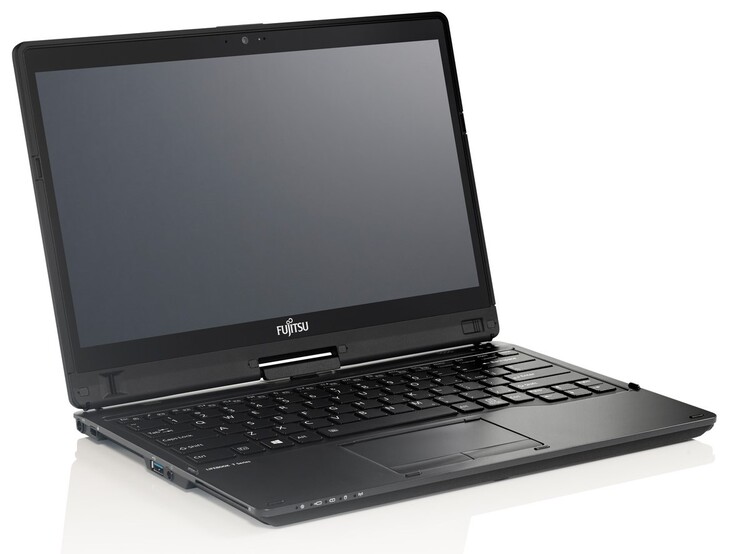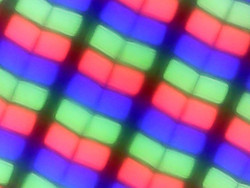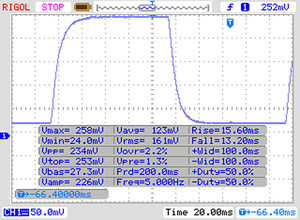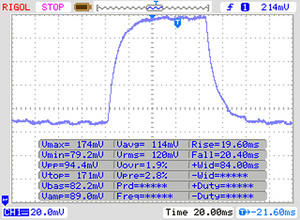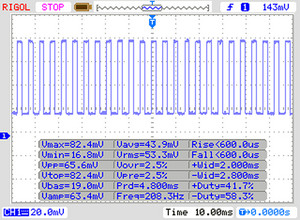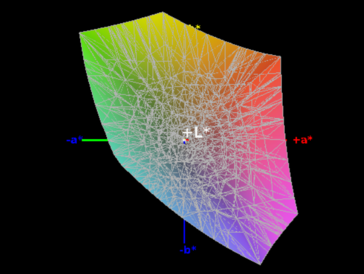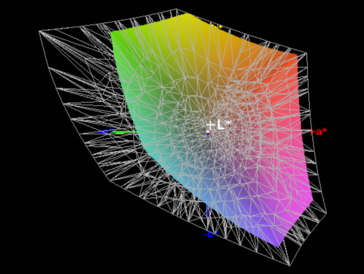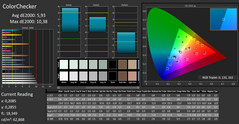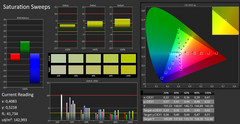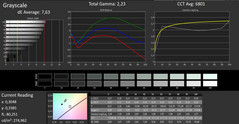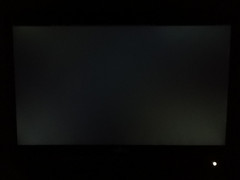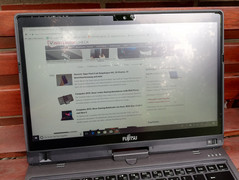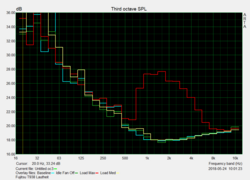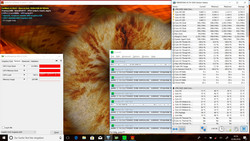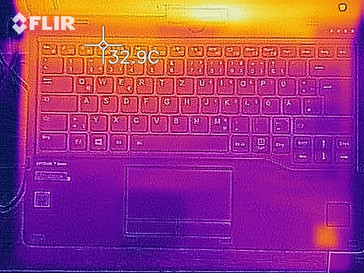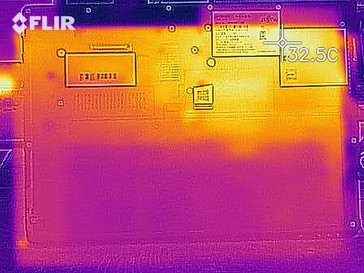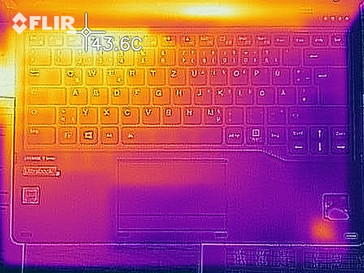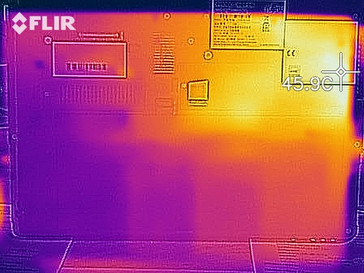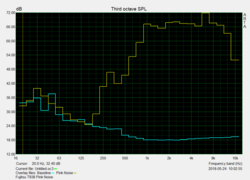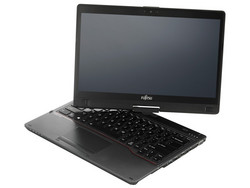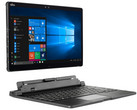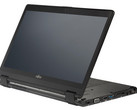Fujitsu Lifebook T938 (i5-8250U, UHD620) Laptop Review

In the business sector, Fujitsu notebooks offer a good, balanced port selection and a lot of security features. This concept also applies to their convertibles, which are regularly updated in accordance with the latest technological advancements. With the Lifebook T938, Fujitsu delivers a 13.3-inch convertible that inherits all of its predecessors' good attributes and comes with the modern Intel Core i5-8250U, UHD Graphics 620, 8 GB RAM and a 256 GB SSD.
Fujitsu does not need to shy away from a comparison with its competition, at least on paper, which is why we compare the 1600 Euros (~$1883) convertible to similarly expensive devices. Those include the Dell Latitude 7285, Lenovo's ThinkPad X1 Yoga 2018, the HP Spectre x360 13 and Acer's Spin 5 SP515-51GN, among others.
Case & Features - Lifebook T938 with weakish Wi-Fi
The top of the base unit is made of metal, whereas the rest of the case is made of robust black plastic. The battery on the bottom can be removed without tools and two maintenance hatches allow for access of the SSD and RAM. There is only one slot for the latter, meaning RAM can only be replaced, and it runs in single-channel mode.
The rotating joint keeps the display in its position firmly, at least as long as it is just opened or closed. The construction seems somewhat fragile when rotating the display vertically in order to switch into tablet mode. Nothing rattles or wiggles during this however, which is why we would call the mechanism robust. Coming in at 1.3 kg, the 13.3-inch convertible is light enough for mobile use. The depth of two centimeters does not have to be viewed as a disadvantage, particularly in tablet mode, since it causes the device to lie in the hand very comfortably.
The Lifebook T938's SD card reader completely swallows SD cards and reaches very good read speeds of 155 MB/s. Although this is not a peak value, it sets the Fujitsu convertible apart from its competition by a significant margin. Our test device also appears to achieve very good Wi-Fi data rates due to the fast ac standard when using the 5 GHz band. Ultimately, the maximum speeds for sending/receiving data were 534/663 Mb/s, respectively. This result puts the T938 in the upper ranks of our comparison.
Connectivity
| SD Card Reader | |
| average JPG Copy Test (av. of 3 runs) | |
| Lenovo ThinkPad X1 Yoga 2018-20LD0015US | |
| HP Spectre x360 13-ae048ng (Toshiba Exceria Pro M501 microSDXC 64GB) | |
| Fujitsu Lifebook T938 (Toshiba Exceria Pro SDXC 64 GB UHS-II) | |
| Average of class Convertible (28.1 - 209, n=23, last 2 years) | |
| Dell Latitude 7285 (Toshiba Exceria Pro M501) | |
| Acer Spin 5 SP515-51GN-80A3 (Toshiba Exceria Pro SDXC 64 GB UHS-II) | |
| maximum AS SSD Seq Read Test (1GB) | |
| Lenovo ThinkPad X1 Yoga 2018-20LD0015US | |
| HP Spectre x360 13-ae048ng (Toshiba Exceria Pro M501 microSDXC 64GB) | |
| Fujitsu Lifebook T938 (Toshiba Exceria Pro SDXC 64 GB UHS-II) | |
| Average of class Convertible (28.9 - 253, n=22, last 2 years) | |
| Dell Latitude 7285 (Toshiba Exceria Pro M501) | |
| Acer Spin 5 SP515-51GN-80A3 (Toshiba Exceria Pro SDXC 64 GB UHS-II) | |
Input Devices - Fujitsu convertible with mediocre touchpad and soft keyboard
The keyboard of the Lifebook T938 has a good key size and is suitable even for longer writing tasks. Only the special keys turned out to be fairly small; however, they are far enough apart to not be pressed erroneously. The pressure point is soft and the keys are very quiet.
The touchpad is definitely usable for moving the cursor, but it reacts poorly to tapping. Thus mouse clicks become very inconsistent, with double clicks being almost impossible. However, the dedicated recessed mouse buttons perform this task excellently. Their pressure point is comfortable and a distinctly audible click confirms every input.
The touchscreen can be used directly with your fingers or with the included stylus. Movements are registered slightly before the tip of the pen touches the display. Navigating the menus, creating handwritten text and drawing sketches feel very natural. Additionally, Fujitsu includes three replacement tips for the stylus in the package.
Display - Fujitsu T938 with strong color accuracy
Fujitsu equips the Lifebook T938 with a 13.3-inch IPS panel. The display has a competitive resolution of 1920x1080 and average brightness of 255 cd/m². The only display choice for prospective buyers to make is the decision between a glossy or matte display.
While Fujitsu uses pulse width modulation to regulate brightness, it only comes into effect at below 20% brightness. Thus, even sensitive eyes should not experience any issues due to a flickering display.
| |||||||||||||||||||||||||
Brightness Distribution: 88 %
Center on Battery: 274 cd/m²
Contrast: 1054:1 (Black: 0.26 cd/m²)
ΔE ColorChecker Calman: 5.93 | ∀{0.5-29.43 Ø4.78}
ΔE Greyscale Calman: 7.63 | ∀{0.09-98 Ø5}
100% sRGB (Argyll 1.6.3 3D)
63% AdobeRGB 1998 (Argyll 1.6.3 3D)
72.9% AdobeRGB 1998 (Argyll 3D)
92.2% sRGB (Argyll 3D)
69.3% Display P3 (Argyll 3D)
Gamma: 2.23
CCT: 6801 K
| Fujitsu Lifebook T938 Sharp SHP141B, , 1920x1080, 13.3" | Dell Latitude 7285 SHP1482 (LQ123Z1), , 2880x1920, 12.3" | Lenovo ThinkPad X1 Yoga 2018-20LD0015US Lenovo LEN40A9, , 1920x1080, 14" | HP Spectre x360 13-ae048ng Chi Mei (CMN1376), , 1920x1080, 13.3" | Acer Spin 5 SP515-51GN-80A3 AUO, B156HAN06.1, , 1920x1080, 15.6" | |
|---|---|---|---|---|---|
| Display | 5% | -11% | 1% | -42% | |
| Display P3 Coverage (%) | 69.3 | 73.3 6% | 60.9 -12% | 68.1 -2% | 38.73 -44% |
| sRGB Coverage (%) | 92.2 | 99.8 8% | 86.4 -6% | 99.5 8% | 58.3 -37% |
| AdobeRGB 1998 Coverage (%) | 72.9 | 74.1 2% | 61.9 -15% | 70.2 -4% | 40.02 -45% |
| Response Times | -11% | -4% | 6% | -6% | |
| Response Time Grey 50% / Grey 80% * (ms) | 39 ? | 44 ? -13% | 40.4 ? -4% | 36 ? 8% | 42 ? -8% |
| Response Time Black / White * (ms) | 28 ? | 30.4 ? -9% | 28.8 ? -3% | 27 ? 4% | 29 ? -4% |
| PWM Frequency (Hz) | 208 ? | 922 ? | 25000 ? | ||
| Screen | 30% | 10% | 17% | 14% | |
| Brightness middle (cd/m²) | 274 | 531 94% | 267.2 -2% | 311 14% | 221 -19% |
| Brightness (cd/m²) | 255 | 490 92% | 239 -6% | 278 9% | 224 -12% |
| Brightness Distribution (%) | 88 | 86 -2% | 75 -15% | 82 -7% | 89 1% |
| Black Level * (cd/m²) | 0.26 | 0.37 -42% | 0.27 -4% | 0.2 23% | 0.12 54% |
| Contrast (:1) | 1054 | 1435 36% | 990 -6% | 1555 48% | 1842 75% |
| Colorchecker dE 2000 * | 5.93 | 3.5 41% | 3.5 41% | 3.98 33% | 4.12 31% |
| Colorchecker dE 2000 max. * | 10.38 | 6.2 40% | 6.4 38% | 8.48 18% | 6.41 38% |
| Greyscale dE 2000 * | 7.63 | 4.7 38% | 1.3 83% | 5.57 27% | 3.4 55% |
| Gamma | 2.23 99% | 2.04 108% | 2.146 103% | 2.51 88% | 2.54 87% |
| CCT | 6801 96% | 6581 99% | 6523 100% | 7810 83% | 6893 94% |
| Color Space (Percent of AdobeRGB 1998) (%) | 63 | 67.6 7% | 56 -11% | 64 2% | 37 -41% |
| Color Space (Percent of sRGB) (%) | 100 | 99.8 0% | 86 -14% | 99 -1% | 58 -42% |
| Colorchecker dE 2000 calibrated * | 3.81 | ||||
| Total Average (Program / Settings) | 8% /
20% | -2% /
4% | 8% /
12% | -11% /
0% |
* ... smaller is better
Display Response Times
| ↔ Response Time Black to White | ||
|---|---|---|
| 28 ms ... rise ↗ and fall ↘ combined | ↗ 15 ms rise | |
| ↘ 13 ms fall | ||
| The screen shows relatively slow response rates in our tests and may be too slow for gamers. In comparison, all tested devices range from 0.1 (minimum) to 240 (maximum) ms. » 70 % of all devices are better. This means that the measured response time is worse than the average of all tested devices (20.2 ms). | ||
| ↔ Response Time 50% Grey to 80% Grey | ||
| 39 ms ... rise ↗ and fall ↘ combined | ↗ 19 ms rise | |
| ↘ 20 ms fall | ||
| The screen shows slow response rates in our tests and will be unsatisfactory for gamers. In comparison, all tested devices range from 0.165 (minimum) to 636 (maximum) ms. » 58 % of all devices are better. This means that the measured response time is worse than the average of all tested devices (31.6 ms). | ||
Screen Flickering / PWM (Pulse-Width Modulation)
| Screen flickering / PWM detected | 208 Hz | ≤ 20 % brightness setting | |
The display backlight flickers at 208 Hz (worst case, e.g., utilizing PWM) Flickering detected at a brightness setting of 20 % and below. There should be no flickering or PWM above this brightness setting. The frequency of 208 Hz is relatively low, so sensitive users will likely notice flickering and experience eyestrain at the stated brightness setting and below. In comparison: 53 % of all tested devices do not use PWM to dim the display. If PWM was detected, an average of 8108 (minimum: 5 - maximum: 343500) Hz was measured. | |||
The IPS panel of the Fujitsu T938 represents colors of the sRGB color space with an accuracy of 100% and thereby goes head to head with our other devices in the comparison. It also manages to reach a very good 63% AdobeRGB color-space coverage. In conjunction with an acceptable contrast ratio of 1.054:1 and a comparatively low black value of 0.26, colors on the display appear authentic and distinct from one another.
The low brightness of the Fujitsu convertible is noticeable outdoors. Even on cloudy days, screen content is difficult to make out and reflections exacerbate the view despite the anti-glare display.
Performance - T938 falls short of expectations
Our test device is equipped with Intel's Core i5-8250U and an integrated UHD Graphics 620. In conjunction with 8 GB RAM and a 256 GB SSD, there is enough performance to ensure problem-free office use. The Intel Core i5-8350U and i7-8650U processors are also available, in case you need more performance. Additionally, the T938 supports up to 16 GB of RAM, whereas there is only one DDR4 slot available, hence the RAM can only operate in single-channel mode. Replacing the RAM and SSD can be performed through the respective maintenance hatch on the bottom of the device.
Processor
Intel's Core i5-8250U CPU has a core clock of up to 3.4 GHz and uses four cores for computing. It is also significantly more energy-efficient than processors of the previous Intel Core generation thanks to the 14 nm manufacturing process. The long-term performance of the CPU heavily depends on how well the system is being cooled.
Our CinebenchR15 endurance test shows very unbalanced results. The values fluctuate widely from one cycle to the next. The performance plummets again and again until the system ramps it up once more. The Lifebook T938 does not manage to distribute its load evenly.
While our test system keeps reaching its maximum theoretical performance at least momentarily, comparable convertibles, while being able to reach a better result, also tend to experience a rapid decline in performance and settle at a lower level in the long run. All in all, Fujitsu still does not exhaust the capabilities of the Core i5-8250U with the Lifebook T938.
The results of other CPUs in comparison to Intel's Core i5-8250U can be viewed on our CPU benchmark page.
System Performance
The Fujitsu convertible falls short of its potential in the PCMark8 benchmark as well. The benchmark results are far below the average scores of comparable devices with an Intel Core i5-8250U. This barely has any impact on day-to-day use. Our subjective impression is positive and the system performed smoothly throughout the entire duration of our tests.
| PCMark 8 Home Score Accelerated v2 | 3121 points | |
| PCMark 10 Score | 2841 points | |
Help | ||
Storage Devices
The inbuilt mass storage of the Lifebook T938 is slow considering it is an SSD. Compared to the competing devices in our review, the Fujitsu convertible has to be content with last place in our comparison list. Of course, the installed Micron 1100 is far quicker than regular HDDs, and it expresses itself through folders opening more quickly and very short loading times when starting programs.
The performance of other mass storage solutions in comparison with the Micron 1100 can be explored on our HDD-/SSD-Benchmark page.
| Fujitsu Lifebook T938 Micron 1100 MTFDDAV256TBN | Dell Latitude 7285 Toshiba KBG20ZMS256G | HP Spectre x360 13-ae048ng Toshiba NVMe THNSN51T02DUK | Acer Spin 5 SP515-51GN-80A3 Intel SSD 600p SSDPEKKW256G7 | Average Micron 1100 MTFDDAV256TBN | Average of class Convertible | |
|---|---|---|---|---|---|---|
| CrystalDiskMark 3.0 | 86% | 121% | 107% | 13% | 1290% | |
| Read Seq (MB/s) | 412.8 | 1017 146% | 919 123% | 1187 188% | 465 ? 13% | 3753 ? 809% |
| Write Seq (MB/s) | 332.4 | 587 77% | 776 133% | 599 80% | 379 ? 14% | 4028 ? 1112% |
| Read 512 (MB/s) | 312 | 756 142% | 620 99% | 935 200% | 315 ? 1% | 950 ? 204% |
| Write 512 (MB/s) | 283.4 | 487.9 72% | 575 103% | 609 115% | 315 ? 11% | 1522 ? 437% |
| Read 4k (MB/s) | 25 | 45.26 81% | 45.99 84% | 35.61 42% | 24.6 ? -2% | 1382 ? 5428% |
| Write 4k (MB/s) | 69.1 | 99.1 43% | 138.1 100% | 134.4 95% | 80.8 ? 17% | 1630 ? 2259% |
| Read 4k QD32 (MB/s) | 178.7 | 357.7 100% | 542 203% | 289.3 62% | 227 ? 27% | 220 ? 23% |
| Write 4k QD32 (MB/s) | 194 | 253 30% | 437.3 125% | 331.1 71% | 233 ? 20% | 292 ? 51% |
Graphics Card
The integrated Intel UHD Graphics 620 inside Fujitsu's Lifebook T938 is responsible for displaying screen content. The GPU has a core clock of up to 1150 MHz (boost) and seizes some of the available RAM. The UHD Graphics 620 profits heavily from dual-channel mode RAM; however, this is something users of the T938 have to pass on.
Of all the devices with this graphics card that we tested, our test device scores the exact average result. Briefly looking at the score of the ThinkPad X1 Yoga 2018 shows that an approximate 10 % of additional performance can be expected when using dual-channel RAM.
The performance of Intel's UHD Graphics 620 relative to other graphics card can be viewed on our GPU benchmark page.
| 3DMark 11 Performance | 1746 points | |
Help | ||
Gaming Performance
The Lifebook T938 is not a gaming device, which is also reflected in the benchmark results. Games from five years ago such as BioShock Infinite can only be displayed smoothly at very low graphics settings on the Fujitsu convertible. However, a lot of casual games that run smoothly on the Lifebook can be found in the Windows Store.
Games that run smoothly with Intel's UHD Graphics 620 can be viewed in our GPU games list.
| low | med. | high | ultra | |
|---|---|---|---|---|
| BioShock Infinite (2013) | 32.6 | 19.8 | 16.22 | 6.2 |
Emissions & Power - Quiet fan inside the Fujitsu Lifebook
Noise emissions
The Fujitsu Lifebook T938 is very quiet during simple office use and barely stands out from environmental sounds at all. Under load, the fan of the convertible ramps up with a whirring sound; however, it is neither disturbing nor unpleasant. While some other convertibles are quieter, our test device is far from noisy.
Noise level
| Idle |
| 30.4 / 30.4 / 30.4 dB(A) |
| Load |
| 31 / 36.9 dB(A) |
 | ||
30 dB silent 40 dB(A) audible 50 dB(A) loud |
||
min: | ||
Temperature
The Lifebook T938 stays cool while running and only heats up to a maximum of 40 °C under load. The warmest spot we measured was to the left at the back of the Fujitsu convertible, directly above the fan exhaust.
In our stress test, we use the system to fully examine whether our test device is able to maintain its clock speed even under extreme conditions. During this, core temperatures reach a maximum of 80 °C and the clock speed drops to 400 MHz. The system does not manage to normalize the frequency within one hour of testing. Since this extreme scenario is almost impossible in practice, however, there should be no limitations due to excessively high core temperatures in day-to-day operation.
(+) The maximum temperature on the upper side is 39.5 °C / 103 F, compared to the average of 35.4 °C / 96 F, ranging from 19.6 to 60 °C for the class Convertible.
(±) The bottom heats up to a maximum of 40.1 °C / 104 F, compared to the average of 36.8 °C / 98 F
(+) In idle usage, the average temperature for the upper side is 24.3 °C / 76 F, compared to the device average of 30.3 °C / 87 F.
(+) The palmrests and touchpad are cooler than skin temperature with a maximum of 25.3 °C / 77.5 F and are therefore cool to the touch.
(+) The average temperature of the palmrest area of similar devices was 27.9 °C / 82.2 F (+2.6 °C / 4.7 F).
Speakers
The speakers of the Fujitsu T938 are not very loud. The sound also becomes scratchy with increasing volume. Highs and mids are played in a still barely acceptable quality. However, the speakers are still suited for occasional playback of audio content, as long as the environment is not too noisy.
Fujitsu Lifebook T938 audio analysis
(-) | not very loud speakers (71.8 dB)
Bass 100 - 315 Hz
(-) | nearly no bass - on average 30.9% lower than median
(±) | linearity of bass is average (10% delta to prev. frequency)
Mids 400 - 2000 Hz
(±) | reduced mids - on average 8.3% lower than median
(±) | linearity of mids is average (9.7% delta to prev. frequency)
Highs 2 - 16 kHz
(+) | balanced highs - only 4.7% away from median
(+) | highs are linear (4.1% delta to prev. frequency)
Overall 100 - 16.000 Hz
(-) | overall sound is not linear (30.5% difference to median)
Compared to same class
» 89% of all tested devices in this class were better, 3% similar, 9% worse
» The best had a delta of 6%, average was 20%, worst was 57%
Compared to all devices tested
» 88% of all tested devices were better, 3% similar, 9% worse
» The best had a delta of 4%, average was 24%, worst was 134%
Apple MacBook 12 (Early 2016) 1.1 GHz audio analysis
(+) | speakers can play relatively loud (83.6 dB)
Bass 100 - 315 Hz
(±) | reduced bass - on average 11.3% lower than median
(±) | linearity of bass is average (14.2% delta to prev. frequency)
Mids 400 - 2000 Hz
(+) | balanced mids - only 2.4% away from median
(+) | mids are linear (5.5% delta to prev. frequency)
Highs 2 - 16 kHz
(+) | balanced highs - only 2% away from median
(+) | highs are linear (4.5% delta to prev. frequency)
Overall 100 - 16.000 Hz
(+) | overall sound is linear (10.2% difference to median)
Compared to same class
» 7% of all tested devices in this class were better, 2% similar, 91% worse
» The best had a delta of 5%, average was 18%, worst was 53%
Compared to all devices tested
» 4% of all tested devices were better, 1% similar, 94% worse
» The best had a delta of 4%, average was 24%, worst was 134%
Energy consumption
The Lifebook T938 is very economical. We measured a maximum consumption of 8 watts during idle. This value climbs to up to 34 watts under load, whereas the included 65 watts power supply is able to serve as a sufficiently sized energy supply at any time.
| Off / Standby | |
| Idle | |
| Load |
|
Key:
min: | |
Battery Life
The Fujitsu T938 reaches a runtime of almost 8 hours in our real-world oriented Wi-Fi test. This is sufficient for an entire workday and forgetting the power supply in the office from time to time is not going to be a problem. While more expensive convertibles last a little bit longer still, the runtime of our test device is appropriate for its price class.
Pros
Cons
Verdict - Business convertible with solid performance
Buyers of the Fujitsu Lifebook T938 will receive a business convertible for day-to-day use that shines with many ports and numerous security features. Additionally, it is easy to perform maintenance on the device and components such as the SSD and RAM can be replaced easily. The installed hardware does not reach its true potential, which becomes particularly apparent in benchmarks.
With the Lifebook T938, Fujitsu offers a convertible that stands out from its competition due to its particular folding mechanism. The performance falls behind the capabilities of the hardware, but the T938 is a suitable business device regardless.
In comparison with other high-priced devices, the Lifebook T938 stands out from its competition mainly due to its display mechanism. Rotating and folding the lid prevents users from permanently feeling the keyboard on the back with their hands. Combined with the included stylus, the T938, while not very handy, becomes a highly robust tablet.
Fujitsu Lifebook T938
- 06/05/2018 v6 (old)
Mike Wobker




